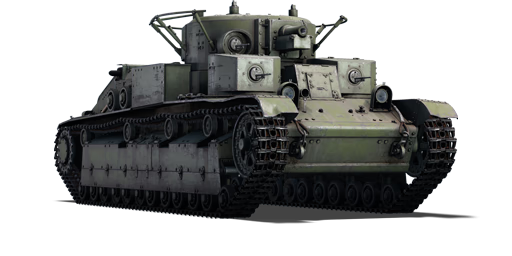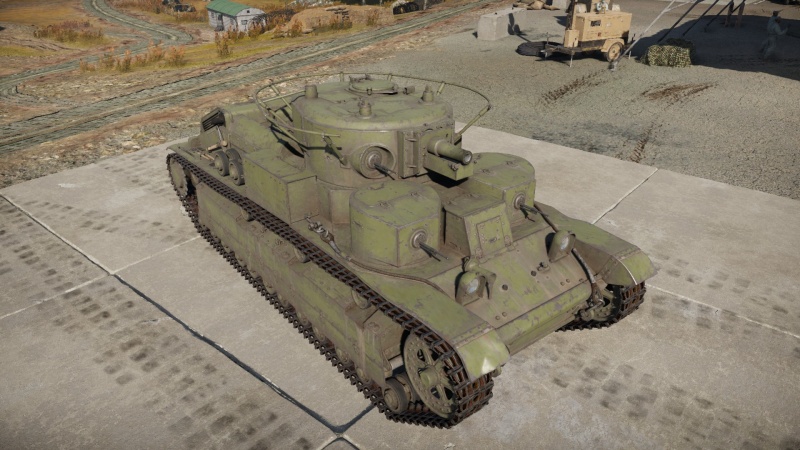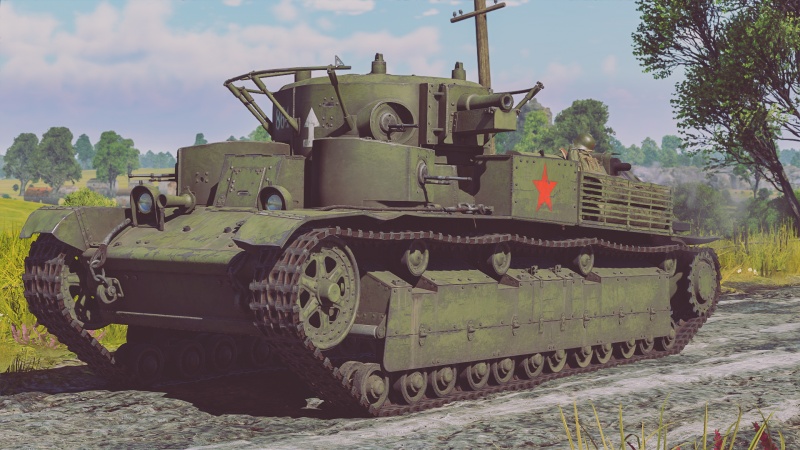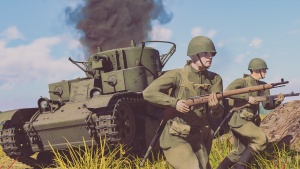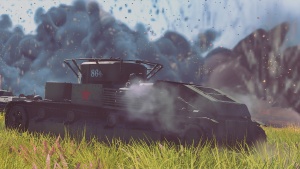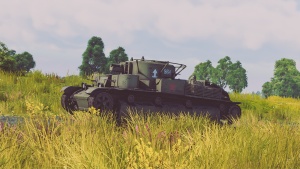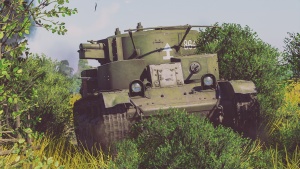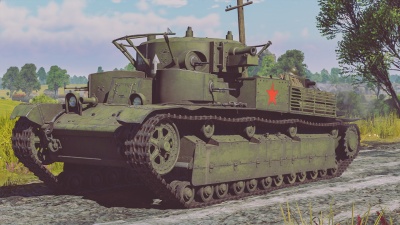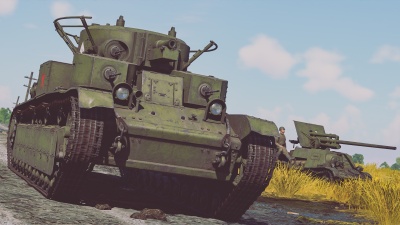Difference between revisions of "T-28 (1938)"
(→Ammunition: Converted to transclusion) |
(→Description) |
||
| (8 intermediate revisions by 4 users not shown) | |||
| Line 12: | Line 12: | ||
<!-- ''In the description, the first part should be about the history of the creation and combat usage of the vehicle, as well as its key features. In the second part, tell the reader about the ground vehicle in the game. Insert a screenshot of the vehicle, so that if the novice player does not remember the vehicle by name, he will immediately understand what kind of vehicle the article is talking about.'' --> | <!-- ''In the description, the first part should be about the history of the creation and combat usage of the vehicle, as well as its key features. In the second part, tell the reader about the ground vehicle in the game. Insert a screenshot of the vehicle, so that if the novice player does not remember the vehicle by name, he will immediately understand what kind of vehicle the article is talking about.'' --> | ||
[[File:T-28 Production (7).jpg|left|thumb|A T-28 supporting infantry]] | [[File:T-28 Production (7).jpg|left|thumb|A T-28 supporting infantry]] | ||
| − | The '''{{Specs|name}}''' | + | The '''{{Specs|name}}''' was a Soviet medium tank developed in the early 1930s as a complement to the heavier T-35 tank, sharing turret and hull design as well as partially the armament. The T-28 was also influenced by the British Vickers A1E1 Independent multi-turreted tank. The T-28 featured three turrets, two armed with 7.62 mm DT machine guns and a third with a 76 mm KT-28 howitzer and coaxial DT machine gun. The role of the T-28 was to provide infantry support, while the BT series tanks were to deal with enemy armour. |
| − | + | It was introduced in [[Update "Ixwa Strike"]]. This production T-28, unlike its following variants ([[T-28]] and [[T-28E]]), is equipped with a KT-28 howitzer with only 34 mm of penetration at 500 m distance with its APHEBC shell, and was primarily used as an infantry support tank. The tank itself is quite mobile for its size and weight, as well as having a decent top speed of 40 km/h. The armour is not particularly strong, and the six crew members being tightly packed together in the hull leave the tank vulnerable to being destroyed in a single well-aimed shot. | |
== General info == | == General info == | ||
| Line 55: | Line 55: | ||
=== Modifications and economy === | === Modifications and economy === | ||
{{Specs-Economy}} | {{Specs-Economy}} | ||
| − | Best way to go through the modification is by starting with FPE and Parts and then go along the line with increasing the Firepower modules increasing the Turret slew rating and increase the gun accuracy, after that would most likely best to advance down the Engine modules to increase the acceleration and HP on the T-28 (1938) engine. Then can finish up the rest of the modules with Artillery Support and Crew Replenishment. | + | Best way to go through the modification is by starting with FPE and Parts and then go along the line with increasing the Firepower modules increasing the Turret slew rating and increase the gun accuracy, after that would most likely best to advance down the Engine modules to increase the acceleration and HP on the T-28 (1938) engine. Then can finish up the rest of the modules with Artillery Support and Crew Replenishment. |
== Armaments == | == Armaments == | ||
| Line 83: | Line 83: | ||
==== Ammunition ==== | ==== Ammunition ==== | ||
| − | {{:KT-28 (76 mm)/Ammunition|BR-350A (MD-5 fuze), OF-350M | + | {{:KT-28 (76 mm)/Ammunition|BR-350A (MD-5 fuze), OF-350M}} |
==== [[Ammo racks]] ==== | ==== [[Ammo racks]] ==== | ||
| Line 129: | Line 129: | ||
{{main|DT (7.62 mm)}} | {{main|DT (7.62 mm)}} | ||
| − | The MGs are | + | The MGs are designed for infantry combat, and are only useful against the most lightly-armoured vehicles, such as open-topped and anti-air vehicles. |
{| class="wikitable" style="text-align:center" width="50%" | {| class="wikitable" style="text-align:center" width="50%" | ||
| Line 148: | Line 148: | ||
<!-- ''Describe the tactics of playing in the vehicle, the features of using vehicles in the team and advice on tactics. Refrain from creating a "guide" - do not impose a single point of view but instead give the reader food for thought. Describe the most dangerous enemies and give recommendations on fighting them. If necessary, note the specifics of the game in different modes (AB, RB, SB).'' --> | <!-- ''Describe the tactics of playing in the vehicle, the features of using vehicles in the team and advice on tactics. Refrain from creating a "guide" - do not impose a single point of view but instead give the reader food for thought. Describe the most dangerous enemies and give recommendations on fighting them. If necessary, note the specifics of the game in different modes (AB, RB, SB).'' --> | ||
| − | For the size of the T-28 (1938), it has quite the mobility and its gun is quite powerful for its BR, though it lacks in penetration against the more armoured vehicles. The T-28 (1938) is | + | For the size of the T-28 (1938), it has quite the mobility and its gun is quite powerful for its BR, though it lacks in penetration against the more armoured vehicles. The T-28 (1938) is best used in a close combat setting, though it will struggle significantly against even reserve tanks like the American M2A4 due to the very low penetration of its gun. Unlike the succeeding versions, the {{PAGENAME}} can't shoot enemy tanks at a middle to long range, so avoid sniping and try to get as close as possible to the enemies. Don't travel in the open, the armour won't last long to enemy fire. |
T-28 (1938) has a couple of vehicles it should beware of and try to avoid in a direct confrontation, for example : [[Marder III]], [[Ho-Ni III]], [[LVT(A)(4) (ZiS-2) (China)]], [[M3 Lee]] and [[Chi-Ha Kai]]. These vehicles can easily knock out the T-28 (1938) before it comes into range to get a secure hit with the [[KT-28 (76 mm)]]. But even if the T-28 (1938) comes within range, it will have quite the trouble doing something against a [[M3 Lee]]'s armour. Which makes it crucial to be in a close quarter battle with most of these vehicles where the T-28 (1938)'s KT-28 gun will do adequate damage. | T-28 (1938) has a couple of vehicles it should beware of and try to avoid in a direct confrontation, for example : [[Marder III]], [[Ho-Ni III]], [[LVT(A)(4) (ZiS-2) (China)]], [[M3 Lee]] and [[Chi-Ha Kai]]. These vehicles can easily knock out the T-28 (1938) before it comes into range to get a secure hit with the [[KT-28 (76 mm)]]. But even if the T-28 (1938) comes within range, it will have quite the trouble doing something against a [[M3 Lee]]'s armour. Which makes it crucial to be in a close quarter battle with most of these vehicles where the T-28 (1938)'s KT-28 gun will do adequate damage. | ||
| − | Having a large crew | + | Having a large crew, it is able to replace vital crew members which will give it a better chance to survive auto-cannons from vehicles such as the [[Pz.II]], [[Ta-Se]] and [[M15 CGMC]] where the large and spread out crew can be a life saver. Large crew can also be a blessing against small cannon fire from 37 mm or 45 mm, but can still be easily decimated by larger guns like 75 mm, 120 mm or 150 mm which can cause devastating blow to the T-28 (1938). |
So in summary, the best way to utilize the vehicle is by close quarter combat against most vehicles. Within a safe range of the KT-28 gun where it can hopefully penetrate enemy vehicles or if the 76 mm shells HE filling will eliminate the vehicle. The mobility can work well in a close combat where if T-28 keeps moving will be hard to hit where the enemy want to hit to destroy. T-28 large crew will also make it able to take a few hit depending on the gun being used against it. | So in summary, the best way to utilize the vehicle is by close quarter combat against most vehicles. Within a safe range of the KT-28 gun where it can hopefully penetrate enemy vehicles or if the 76 mm shells HE filling will eliminate the vehicle. The mobility can work well in a close combat where if T-28 keeps moving will be hard to hit where the enemy want to hit to destroy. T-28 large crew will also make it able to take a few hit depending on the gun being used against it. | ||
| Line 170: | Line 170: | ||
* Big silhouette and profile, difficult to hide | * Big silhouette and profile, difficult to hide | ||
* Poorly armoured vehicle | * Poorly armoured vehicle | ||
| + | * Lack of penetration means any tank with armour (such as the ubiquitous M2A4) can be a big challenge, even at point blank range | ||
* Low muzzle velocity makes long distance targeting difficult | * Low muzzle velocity makes long distance targeting difficult | ||
| Line 227: | Line 228: | ||
* ''reference to the series of the vehicles;'' | * ''reference to the series of the vehicles;'' | ||
* ''links to approximate analogues of other nations and research trees.'' --> | * ''links to approximate analogues of other nations and research trees.'' --> | ||
| + | |||
* [[T-28]] | * [[T-28]] | ||
* [[T-28E]] | * [[T-28E]] | ||
Latest revision as of 10:44, 25 November 2023
| This page is about the Soviet medium tank T-28 (1938). For other versions, see T-28 (Family). |
Contents
Description
The T-28 (1938) was a Soviet medium tank developed in the early 1930s as a complement to the heavier T-35 tank, sharing turret and hull design as well as partially the armament. The T-28 was also influenced by the British Vickers A1E1 Independent multi-turreted tank. The T-28 featured three turrets, two armed with 7.62 mm DT machine guns and a third with a 76 mm KT-28 howitzer and coaxial DT machine gun. The role of the T-28 was to provide infantry support, while the BT series tanks were to deal with enemy armour.
It was introduced in Update "Ixwa Strike". This production T-28, unlike its following variants (T-28 and T-28E), is equipped with a KT-28 howitzer with only 34 mm of penetration at 500 m distance with its APHEBC shell, and was primarily used as an infantry support tank. The tank itself is quite mobile for its size and weight, as well as having a decent top speed of 40 km/h. The armour is not particularly strong, and the six crew members being tightly packed together in the hull leave the tank vulnerable to being destroyed in a single well-aimed shot.
General info
Survivability and armour
As for most early war tanks, the armour isn't much to write home about. Most if not all other cannons will punch through the thickest armour of 30 mm or put a shell through the thin 20 mm sides. The only reason this tank will survive longer than other early war tanks is the amount of crew sitting around, especially the MG turret crew.
Armour type:
| Armour | Front (Slope angle) | Sides | Rear | Roof |
|---|---|---|---|---|
| Hull | 30 mm | 20 mm Top 20+10 mm Bottom |
20 mm | 10-15 mm |
| Turret | 20 mm Turret front 20mm Gun mantlet |
20 mm | 20 mm | 10-15 mm |
| Cupola | 10 mm | 10 mm | 10 mm | 10 mm |
Notes:
The suspensions are protected by a 10 mm side skirt.
Mobility
| Game Mode | Max Speed (km/h) | Weight (tons) | Engine power (horsepower) | Power-to-weight ratio (hp/ton) | |||
|---|---|---|---|---|---|---|---|
| Forward | Reverse | Stock | Upgraded | Stock | Upgraded | ||
| Arcade | 43 | 8 | 25.4 | 775 | 954 | 30.51 | 37.56 |
| Realistic | 39 | 8 | 442 | 500 | 17.4 | 19.69 | |
Like all the others T-28, the T-28 (1938) has relatively good mobility, with good acceleration and a top speed of 40 km/h (44 in arcade). Its 500 horsepower engine (954 in Arcade) will allow it to exploit holes in the enemy lines.
Modifications and economy
Best way to go through the modification is by starting with FPE and Parts and then go along the line with increasing the Firepower modules increasing the Turret slew rating and increase the gun accuracy, after that would most likely best to advance down the Engine modules to increase the acceleration and HP on the T-28 (1938) engine. Then can finish up the rest of the modules with Artillery Support and Crew Replenishment.
Armaments
Main armament
The T-28 (1938) is armed with a KT-28 howitzer, the same gun as the T-35 and the T-26-4. As a howitzer, the trajectory of the shell will compel you to get closer if you want to hit. The APHEBC shell is filled with 155 g of TNT, making sure all penetrated vehicles are knocked out after a single shot. The penetration is rather poor but is not a big problem at this BR, as almost all the vehicles you'll face won't have enough armour. The only real curve of using this gun is the velocity which is at max 387 m/s for HE & 370 m/s for the APHEBC.
| 76 mm KT-28 | Turret rotation speed (°/s) | Reloading rate (seconds) | |||||||||||
|---|---|---|---|---|---|---|---|---|---|---|---|---|---|
| Mode | Capacity | Vertical | Horizontal | Stabilizer | Stock | Upgraded | Full | Expert | Aced | Stock | Full | Expert | Aced |
| Arcade | 69 | -5°/+25° | ±180° | N/A | 14.3 | 19.8 | 24.0 | 26.5 | 28.2 | 5.20 | 4.60 | 4.24 | 4.00 |
| Realistic | 8.9 | 10.5 | 12.8 | 14.1 | 15.0 | ||||||||
Ammunition
| Penetration statistics | |||||||
|---|---|---|---|---|---|---|---|
| Ammunition | Type of warhead |
Penetration @ 0° Angle of Attack (mm) | |||||
| 10 m | 100 m | 500 m | 1,000 m | 1,500 m | 2,000 m | ||
| BR-350A (MD-5 fuze) | APHEBC | 37 | 37 | 34 | 30 | 27 | 25 |
| OF-350M | HE | 11 | 11 | 11 | 11 | 11 | 11 |
| Shell details | ||||||||||||
|---|---|---|---|---|---|---|---|---|---|---|---|---|
| Ammunition | Type of warhead |
Velocity (m/s) |
Projectile mass (kg) |
Fuse delay (m) |
Fuse sensitivity (mm) |
Explosive mass (TNT equivalent) (g) |
Ricochet | |||||
| 0% | 50% | 100% | ||||||||||
| BR-350A (MD-5 fuze) | APHEBC | 370 | 6.3 | 1.2 | 14 | 155 | 48° | 63° | 71° | |||
| OF-350M | HE | 387 | 6.2 | 0.05 | 0.1 | 710 | 79° | 80° | 81° | |||
Ammo racks
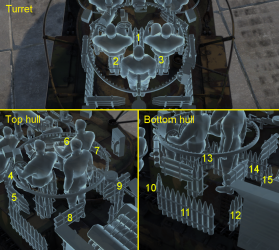
| Full ammo |
1st rack empty |
2nd rack empty |
3rd rack empty |
4th rack empty |
5th rack empty |
6th rack empty |
7th rack empty |
8th rack empty |
|---|---|---|---|---|---|---|---|---|
| 69 | 62 (+7) | 56 (+13) | 50 (+19) | 47 (+22) | 44 (+25) | 41 (+28) | 39 (+30) | 36 (+33) |
| 9th rack empty |
10th rack empty |
11th rack empty |
12th rack empty |
13th rack empty |
14th rack empty |
15th rack empty |
Visual discrepancy |
|
| 33 (+36) | 30 (+39) | 20 (+49) | 17 (+52) | 14 (+55) | 4 (+65) | 1 (+68) | No |
Notes:
- Shells are modeled individually and disappear after having been shot or loaded.
- If you pack 50 (+19) shells, it will keep the turret empty of ammo.
- If you pack 33 (+36) shells, it will keep the turret and the top hull empty of ammo.
Machine guns
The MGs are designed for infantry combat, and are only useful against the most lightly-armoured vehicles, such as open-topped and anti-air vehicles.
| 7.62 mm DT | ||||
|---|---|---|---|---|
| Mount | Capacity (Belt) | Fire rate | Vertical | Horizontal |
| Coaxial | 2,646 (63) | 600 | ±15° | ±15° |
| Left Turret | 2,646 (63) | 600 | -5°/+28° | -155°/+5° |
| Right Turret | 2,646 (63) | 600 | -5°/+28° | -33°/+145° |
Usage in battles
For the size of the T-28 (1938), it has quite the mobility and its gun is quite powerful for its BR, though it lacks in penetration against the more armoured vehicles. The T-28 (1938) is best used in a close combat setting, though it will struggle significantly against even reserve tanks like the American M2A4 due to the very low penetration of its gun. Unlike the succeeding versions, the T-28 (1938) can't shoot enemy tanks at a middle to long range, so avoid sniping and try to get as close as possible to the enemies. Don't travel in the open, the armour won't last long to enemy fire.
T-28 (1938) has a couple of vehicles it should beware of and try to avoid in a direct confrontation, for example : Marder III, Ho-Ni III, LVT(A)(4) (ZiS-2) (China), M3 Lee and Chi-Ha Kai. These vehicles can easily knock out the T-28 (1938) before it comes into range to get a secure hit with the KT-28 (76 mm). But even if the T-28 (1938) comes within range, it will have quite the trouble doing something against a M3 Lee's armour. Which makes it crucial to be in a close quarter battle with most of these vehicles where the T-28 (1938)'s KT-28 gun will do adequate damage.
Having a large crew, it is able to replace vital crew members which will give it a better chance to survive auto-cannons from vehicles such as the Pz.II, Ta-Se and M15 CGMC where the large and spread out crew can be a life saver. Large crew can also be a blessing against small cannon fire from 37 mm or 45 mm, but can still be easily decimated by larger guns like 75 mm, 120 mm or 150 mm which can cause devastating blow to the T-28 (1938).
So in summary, the best way to utilize the vehicle is by close quarter combat against most vehicles. Within a safe range of the KT-28 gun where it can hopefully penetrate enemy vehicles or if the 76 mm shells HE filling will eliminate the vehicle. The mobility can work well in a close combat where if T-28 keeps moving will be hard to hit where the enemy want to hit to destroy. T-28 large crew will also make it able to take a few hit depending on the gun being used against it.
Pros and cons
Pros:
- Numerous crew members grant a longer survivability
- Good mobility
- Armour-piercing shells filled with a large explosive will allow you to take out most tanks with a single shot
- Shrapnel shells are useful to destroy trucks and armoured cars
Cons:
- Big silhouette and profile, difficult to hide
- Poorly armoured vehicle
- Lack of penetration means any tank with armour (such as the ubiquitous M2A4) can be a big challenge, even at point blank range
- Low muzzle velocity makes long distance targeting difficult
History
| The T-28 (1938) represents the T-28 Model 1936. |
Development
The T-28 Model 1934 (first production T-28 variant) was modified with steel wheels for the number four and five suspension bogies starting in 1936. They were also modified with a new turret roof that had two hatches; it is not known if these modifications were applied at the same time or separately. The commander's hatch on the left side received a P-40 anti-aircraft machine gun mount. Additionally, the 71-TK-1 radio set was replaced by the improved 71-TK-3. The engine air intakes were later changed as well, either in 1936 or 1937. T-28s with these changes were called the T-28 Model 1936 for obvious reasons. Other than the above stated changes they were identical to T-28 Model 1934 tanks.[1]
Design
The T-28 Model 1936 had a three-turret design, with a central three-man turret and two smaller one-man auxiliary machine gun turrets located in front and to each side of the main turret. The crew complement was six with a driver in the hull front, a gunner in each auxiliary turret, and a gunner, loader, and commander in the main turret. The engine and transmission were located at the rear of the hull with fuel tanks on each side of it. The weight is stated to be around 25 tonnes but that number depends on the source. A 71-TK-3 radio set was provided which was a feature not all too common at the time.
The primary armament was a 76.2 mm KT-28 howitzer located in the main turret alongside a coaxial 7.62 mm DT machine gun. The main gun could elevate 25° and depress 5° and the main turret could traverse a full 360°. Each auxiliary turret was armed with a single 7.62 mm DT machine gun. Finally, a 7.62 mm DT machine gun could be mounted on the commander's cupola for a total of four 7.62 mm machine guns. The ammunition load was 70 76.2 mm rounds and 7,938 rounds of 7.62 mm ammunition (2,646 rounds per three standard machine guns, not including optional anti-aircraft machine gun).
The engine used was a 48 liter, 500 horsepower V12 M-17T aircraft engine. This powerful engine allowed a speed of around 40-45 km/h to be reached, with the number depending on the source. The downside of the engine was that the high-octane gasoline fuel was incredibly volatile when hit by enemy fire. The transmission had four forward gears and one reverse gear.
The suspension consisted of 12 steel road wheels, all rubber rimmed except for the two pairs on the fourth and fifth bogies. The drive sprocket was at the rear and the idler wheel was at the front of the suspension. There were four return rollers. Note: all of these numbers are for each side meaning the total amount of the components would be double the numbers listed. The tracks were 45 cm (17.7 inches) wide - relatively thin for the size of the vehicle.
The armour protection was relatively thin for such a large tank with a maximum thickness of 30 mm on the front and 20 mm on the sides and rear. The sides of the hull, though, were also protected by side skirts.[1][2]
Production and Service
Around 500-600 (depending on the source) total T-28 medium tanks of all variants were built from 1933 to 1941, when the T-34 superseded it on production lines.
The Soviet heavy armoured brigades consisted of 136 T-28 and 37 BT tanks in 1939. T-28s were often used more on the Sino-Mongolian border against the Japanese Imperial Army but were also used in European actions. Notable actions in the east included the Nomonhan incident and border classes of 1938 through late 1939. The first combat use of the T-28 in Europe was against Poland during the Soviet invasion of Poland in 1939.
The T-28 was used very heavily during the Winter War of 1939-1940 which was a Soviet invasion of Finland. The T-28s were used in the assault against the heavily fortified Mannerheim line. During the conflict around 200 T-28s were knocked out by Finnish anti-tank guns, artillery, or ambushes. Oftentimes the knocked out T-28s were recovered in working condition and were reused after some repairs, up to five times during the conflict. A total of seven T-28s were captured by Finnish forces and used against the Soviet Red Army, nicknamed "ostivaunu" which means "wagon coaches". During the war it quickly became apparent to the Red Army that the T-28 did not have sufficient armour and so the T-28E up-armoured version was produced and earlier models were modified in the field with the increased armour. It was these vehicles that finally broke through the Mannerheim line in 1940 and forced the Finns to sue for peace.
Even by June 1941 there remained 411 T-28s on the Western front, as reported by official numbers. That same month the German Operation Barbarossa - the invasion of the USSR - began and most of the T-28 tanks were knocked out in just the first two months of combat. Not all of them were knocked out by enemy tanks, many broke down due to lack of spare parts and poor maintenance. At least one was captured by the Germans - designated T-28 746(r) - and also at least one by the Hungarians. The last running T-28s were used in the defense of Moscow and Leningrad but were removed from frontline service by 1942 due to them having become obsolete by that time. They were then only used for training and parts.
Turkey apparently received two T-28s and used them in the 1st Tank Regiment of the 2nd Cavalry Division based at Luleburgaz.[2]
Surviving Vehicles
A few T-28 tanks survive to this day including two at the museum in Parola, Finland and one in Moscow, Russia which happens to be the only remaining T-28 Model 1936 left in the world.[1][2]
Media
- Skins
- Images
See also
External links
References
| Leningrad Kirov Plant (Ленинградский Кировский Завод) | |
|---|---|
| Medium Tanks | |
| T-28 | T-28 (1938) · T-28 · T-28E |
| T-80 | T-80B · T-80U · T-80UK · T-80BVM |
| Heavy Tanks | |
| KV-1 | KV-1 (L-11) · KV-1 (ZiS-5) · KV-1E · KV-1S |
| KV-2 | KV-2 (1939) · KV-2 (1940) · KV-2 (ZiS-6) |
| Other | SMK · KV-220 · IS-7 · Object 279 |
| Captured | |
| KV | ▀KV-IB · ▀KW I C 756 (r) · ▀KW II 754 (r) |
| Other | T-28 (Sweden) |
| Export | T-80U (Sweden) |
| See Also | Chelyabinsk Tractor Plant |
| USSR medium tanks | |
|---|---|
| T-28 | T-28 (1938) · T-28 · T-28E |
| T-34-76 | T-34 (Prototype) · T-34 (1940) · T-34 (1941) · T-34 (1st Gv.T.Br.) · T-34 (1942) · T-34E STZ · T-34E |
| T-34-57 | T-34-57 · T-34-57 (1943) |
| T-34-85 | T-34-85 (D-5T) · T-34-85 · T-34-85E |
| T-34-100 | T-34-100 |
| T-44 | T-44 · T-44-100 · T-44-122 |
| T-54 | T-54 (1947) · T-54 (1949) · T-54 (1951) |
| T-55 | TO-55 · T-55A · T-55AM-1 · T-55AMD-1 |
| T-62 | T-62 · T-62M-1 |
| T-64 | Object 435 · T-64A (1971) · T-64B |
| T-72 | T-72A · T-72AV (TURMS-T) · T-72B · T-72B (1989) · T-72B3 · T-72M2 Moderna |
| T-80 | T-80B · T-80U · T-80UD · T-80UK · T-80UM2 · Т-80U-Е1 · T-80BVM · Object 292 |
| T-90 | Т-90А · T-90M |
| Trophies/Lend-Lease | |
| Germany | ▂T-III · ▂T-V |
| Great Britain | ▂МК-IX "Valentine" |
| USA | ▂M3 Medium · ▂M4A2 |


